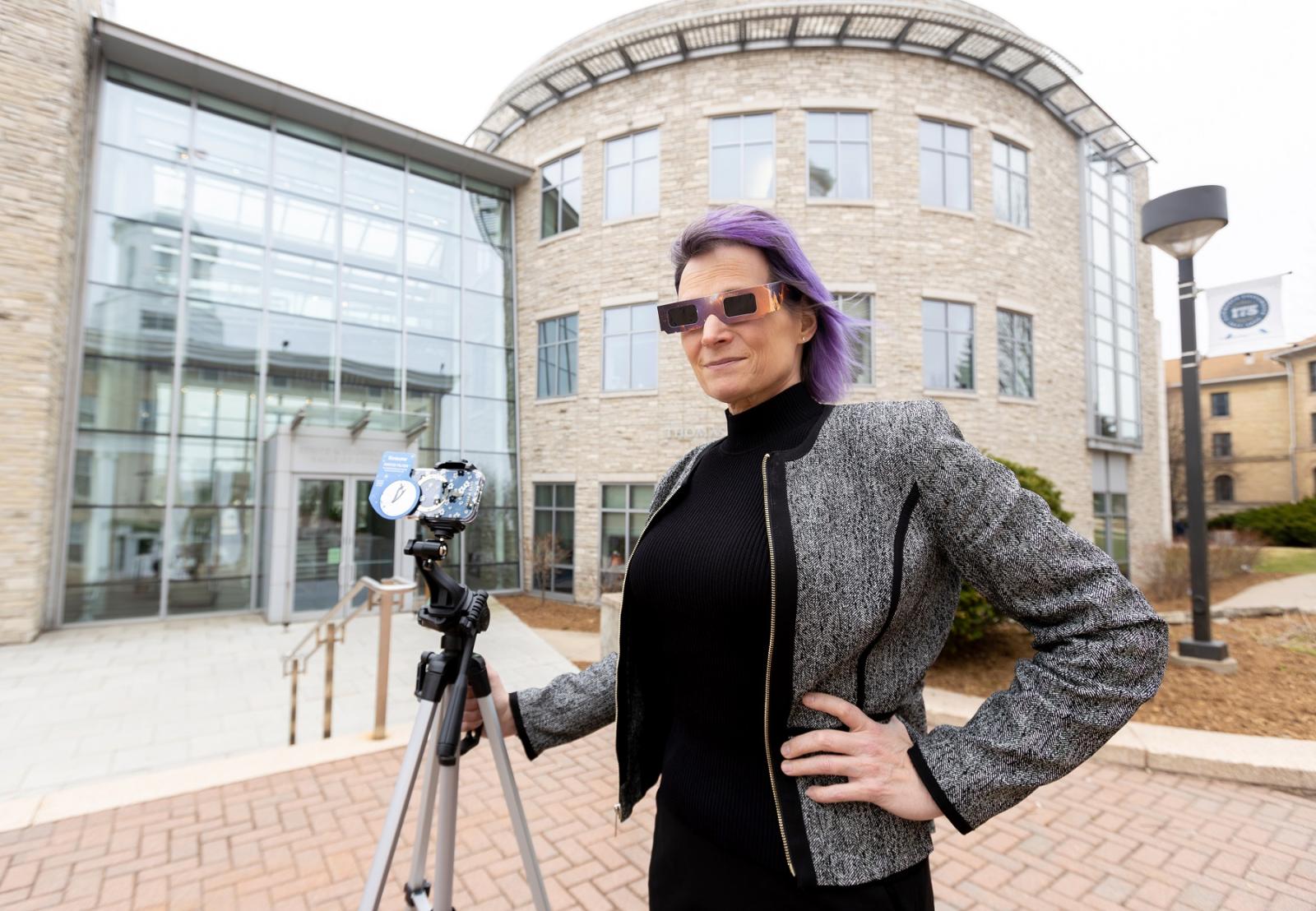Megan Pickett is so fired up for the arrival of the total solar eclipse on April 8 that she wants to share it with the Lawrence University community and beyond.
The associate professor of physics will be livestreaming the eclipse on YouTube from Austin, Texas, one of the U.S. locations that will be in the path of totality.
“I’ve been looking forward to this eclipse—and the previous eclipse in 2017—since I was in grad school at Indiana University in the early ’90s,” Pickett said.
Eclipse Livestream
Livestream will begin on April 8, at 12:20 p.m. Central.
Pickett is a junkie for all things celestial. She has focused much of her academic research on the formation of solar systems. Before joining the Lawrence faculty in 2006, she worked as a research associate at NASA’s Ames Research Center in California. She teaches about celestial histories, delivered a 2021 Convocation address on protecting the night sky, and periodically holds court on Main Hall Green to teach anyone willing to listen about the wonders of star gazing.
The total eclipse of 2017 was her first, viewed from St. Louis. In that one, the path of totality swept across the contiguous United States from northwest to southwest. Pickett called it a “moving, deeply transcendent moment” and said she cried.
“I suspect I will again,” she said.
Explore the laws of the universe through individualized research, multidisciplinary courses, and collaborative experiences.
This year’s total eclipse—it will be the last one visible from the lower 48 states until 2044—will move southwest to northeast across the U.S., from Texas to Maine. To experience all the stages of the total solar eclipse, you will need to view it from somewhere along the path of totality that is no more than 115 miles wide.
Hence, Pickett’s trip to Austin, complete with gear to livestream the whole thing.
In Appleton, the sun will be 85% covered at maximum totality, at about 2:08 p.m., Pickett said.
“Because our eyes are not great detectors of light level changes, and because the light changes slowly over the two-hour eclipse time—allowing our pupils to gradually dilate as the partial eclipse occurs—viewers in Appleton will not notice a significant dimming unless they go outside at 20-minute intervals,” she said.
No one should look directly at the sun during the partial eclipse, Pickett said.
“Your eyes will automatically and reflexively close to protect you should you glance at it, as they do every day,” she said. “And you should never look through binoculars or a telescope at the sun without a proper filter on the device itself. An alternative, and much safer, method for viewing the eclipse is to project the image. In fact, the holes in leaves and between leaves in a tree will all act like pinhole cameras and project an image of the crescent sun on the ground during the eclipse.”
For those viewing from the path of totality, it’ll be a different experience. Here’s what Pickett said people can expect:
“For those lucky enough to get to totality, the sun’s surface will be blocked for about three minutes, depending on how close you are to the center line of the eclipse,” Pickett said. “During totality, it is perfectly safe to look at the sun with your eyes or other devices.
“As totality approaches, viewers will feel a noticeable cooling as they see the shadow of the moon sweep across the horizon toward them. Ducks land for what they think is the evening; birds start their evening song, and crickets will chirp. The sky becomes noticeably dark to the human eye at around 99% coverage.
“At totality, some of the brightest stars may be visible; Jupiter and Venus will be easily seen—Jupiter to the east and Saturn to the west. In addition to the planets, Comet Pons-Brooks (12P), called the ‘devil comet’ for its violent activity, will be approaching perihelion and quite close to Jupiter. The sky doesn’t become completely dark—there’s a pearly iridescence near the horizon as you are surrounded by a ‘sunset’ caused by the moon’s shadow. The sun is also near its peak activity cycle, so viewers may be treated to reddish, arching prominences from the sun that appear from behind the lunar limb.
“And then, quite suddenly, it’s over,” Pickett continued. “The next total solar eclipse to appear in the U.S. won’t be for another 20 years.”
This eclipse will differ from 2017 in a significant way—its path crosses multiple metropolitan areas, including San Antonio, Dallas, and Austin in Texas, Little Rock in Arkansas, Carbondale in Illinois, Indianapolis in Indiana, Dayton, Toledo, and Cleveland in Ohio, Buffalo, Rochester, and Syracuse in New York, and Burlington in Vermont. Pickett said about 32 million people live along this path, and the federal government is estimating that 3 to 4 million people will travel to points along the path of totality.
“I highly recommend people go see this,” Pickett said. “In my hometown in Rochester, schools and grocery stores are closing, people are taking the day off. Just be aware that travel time anywhere to the path of totality will be long. When I saw the 2017 eclipse, I was in bumper-to-bumper traffic for five hours.”
Pickett will begin her livestream from the beginning of the eclipse to just after totality. In Austin, the eclipse will be visible from 1:32 to 1:41 p.m. CST. Those in Austin will experience about 1 minute and 46 seconds of the total solar eclipse at about 1:36 p.m.





